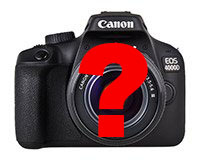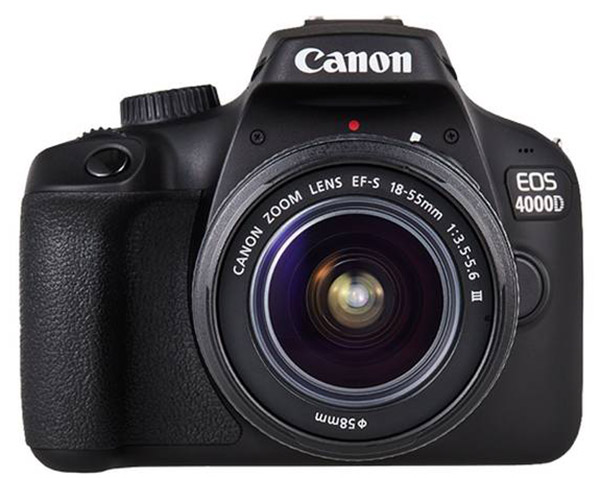Canon 4000D: Dumb idea or canny plan? (Please let it be the latter…)
posted Friday, March 2, 2018 at 7:39 PM EDT

I just read Jeremy's opinion piece on the newly-announced (in some parts of the world, but not the US) Canon EOS 4000D, though, and a thought occurred to me: What if things aren't quite as they appear on the surface, and it isn't a totally dumb idea?
Read Jeremy's article for the details, but the basics are that the 4000D is a very stripped-down camera using technology that's a good couple of years old. The image sensor, AF system, and image processor are all one or two generations back, performing well below the current state of the art, and the LCD panel looks like something from 2005. And a plastic lens mount.
It looks like a camera built to be really, seriously dirt-cheap, but the announced price translates into $500 US (?!)
Really?
As Jeremy points out, you can get a heck of a lot more camera these days for not much more money; Nikon's very nice little D3400 sells for that price now, and you can get it in a two-lens kit with a 70-300mm zoom thrown into the bargain for only about $100 more. Right now I'm looking at a bundle on Amazon for a Sony A6000 that includes a 32GB memory card, carrying case and mini-tripod for only $50 more. Canon's own last-generationl T6 can be had in a two-lens kit for just $499, and it has a vastly better LCD screen and a metal lens mount (but the same sensor, processor and AF).
So what gives? The EOS 4000D looks like it was designed to be a super-affordable camera that would be a great start for students or perhaps play well in global markets where even $500 for a camera would be a prohibitive investment.
The 4000D looks like it's built to be sold for $400 or even less, but at $500? We're left wondering who would buy it.

Canon's secret plan?
But what if Canon doesn't actually plan on selling them at the $500 price? What if the plan is actually to sell them much cheaper, possibly under some kind of special circumstances?
This is all blue-sky speculation of course, but knowing something about the market and how Canon is structured globally, it seems plausible to me that this could be the actual plan.
The first thing to understand is that Canon's global structure is very different from that of other manufacturers. Most camera companies are set up such that the regional and national organizations are subsidiaries of the parent corporation. They have separate corporate identity and local budgeting, but there's a considerable degree of central management and budgeting. Generally, profits flow back to the mothership, and marketing dollars are then doled back out.
Canon is quite different, in that the regional/national entities are completely separate businesses. Relative to camera and lens sales, the setup is that Canon Inc. in Japan is a manufacturer with a very short and exclusive list of customers, namely their regional organizations. Canon Inc. builds cameras and sells them to the regional companies, who then sell them on to consumers. Canon Inc. makes a profit from the sale of the cameras, and uses it to fund R&D, manufacturing innovation, the costs of materials and operations, and of course dividends for their stockholders. The regional companies buy the cameras at whatever cost Canon Inc. has set, sells them in their indivual markets, and uses whatever profits they earn to pay their own operating costs, marketing expenses, service organizations, etc. How they allocate the profits is entirely up to them.
While I'm sure Canon Inc. has some requirements that the products be sold at roughly equivalent costs around the world (so grey-market doesn't become too much of a problem), the regional players manage their budgets however they like, completely on their own. They may choose to invest more or less in their service organizations, spend more or less on marketing, manage their operating expenses however they like, etc. All this is funded by the spread between the cost they sell the products at and what they pay Canon Inc. for them. (One example of this independence is that Canon USA has elected to invest very heavily in their service organization, which is arguably unparalleled anywhere in the world. Other national organizations might spend less on service but more on marketing. Or they might sell the products at lower prices relative to exchange rates. Etc, etc...)
With that as background, what if the plan with the 4000D is to show an "official" price for it high enough to not threaten Canon's more mainstream products, but to build and sell it to the regional companies cheaply enough to give them some serious margin to play with, so they can sell it at cut-rate prices through whatever means they want to in their local markets?
Jeremy's observation was that the 4000D looks like it was assembled from leftovers, and it certainly has that feeling about it.
But what I see when I look at its parts list is a lot of technology that Canon has already fully amortized their development costs for.
In any company, when you spend R&D to develop something, you recover that cost by building it into the pricing and P&L for the product, over some expected number of units sold. In the case of the 4000D, the development investment in the sensor, AF system and processor was recovered long ago, so the going-forward internal costs of those parts are very low.
Hence my guess is that the internal price from Canon Inc. to the local companies for the 4000D is very low. Like, really, seriously cheap.
This gives the local companies a lot of room to get creative with how they sell it, as long as they can do it in ways that won't cause global problems with grey-marketing and the low end of Canon's mainstream product line.
For instance, if they wanted, a local company would be free to set up some special deal for the education market, whereby students could buy 4000Ds through their college bookstores or as part of a photography curriculum for the kind of price that'd make sense for a product like this. I don't know just how cheap the 4000D is to manufacture relative to Canon's other cameras, but I think it's not inconceivable that it could be sold for $350 and still make enough profit to be worth doing. (Maybe even $300?) Especially if it could be used to gather a new generation of photographers into the Canon fold, who'd be customers for other mainstream Canon gear down the line.
Or maybe schools could bulk-purchase 4000Ds for their photography curricula directly from a local Canon organization (that is, without needing to worry about a dealer's profit margin) at those kinds of very low prices?
Who knows, maybe there could be special deals for camera clubs, or some sort of a special offer for new moms looking for something better than their cell phones to take baby pictures with?
Whatever the case, when I look at the 4000D, I see a camera designed to sell for a very low price, but listed much higher. That pricing doesn't make sense, but I'll bet you a donut that we'll see it selling various places around the world, possibly through some sort of special closed-ended or limited distribution, for a whole lot less than the price in the press release.
At least I hope so; it would be great to see real cameras getting into the hands of large swathes of people who simply can't afford them currently.